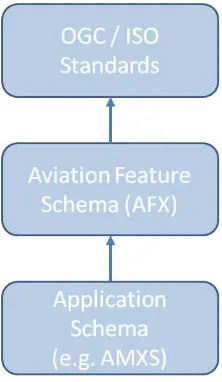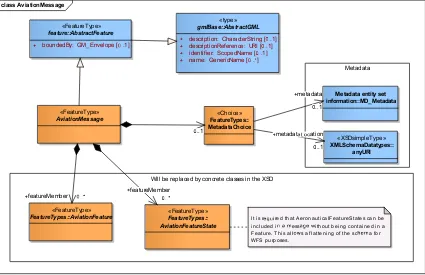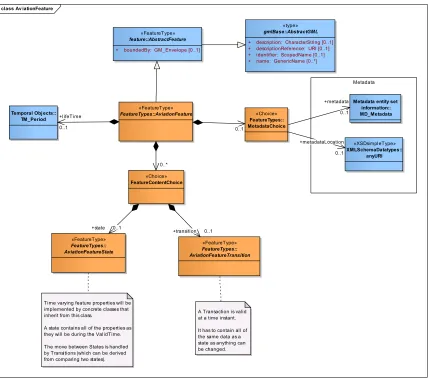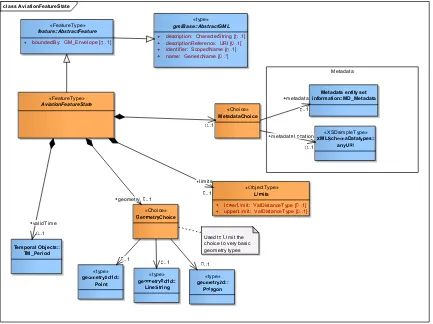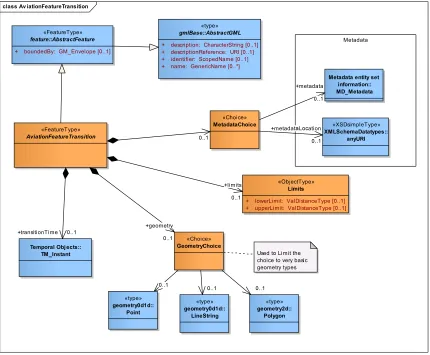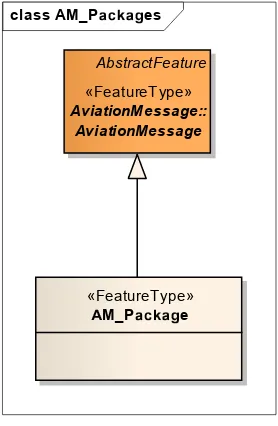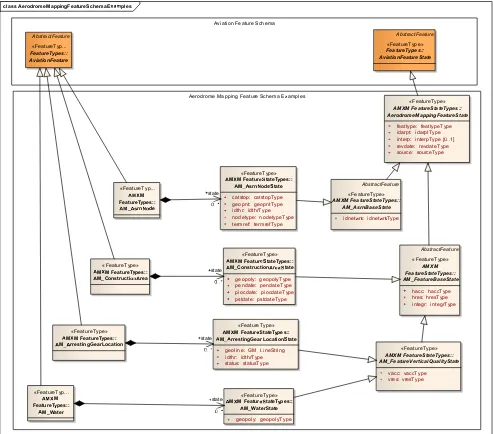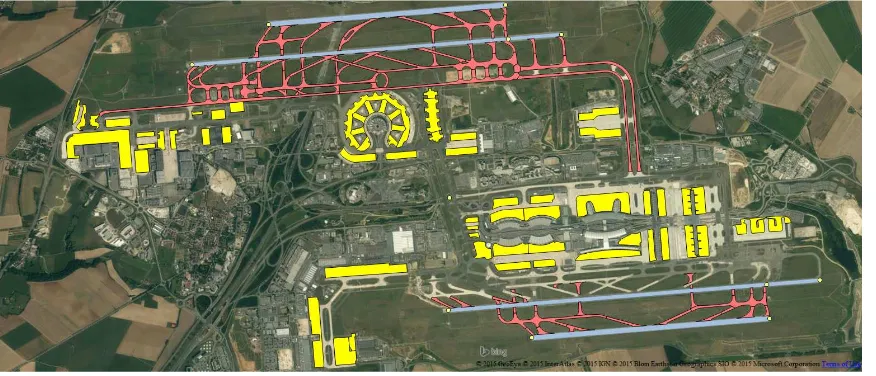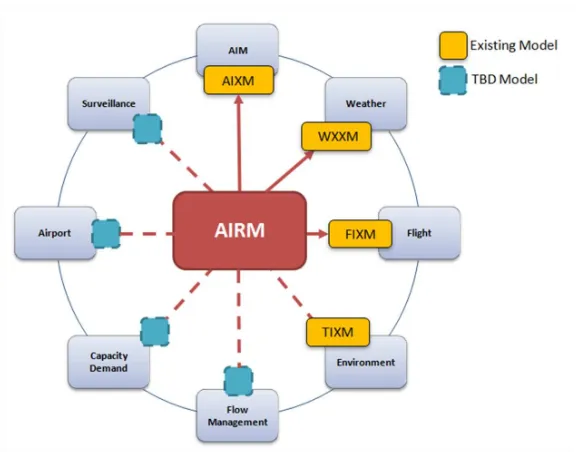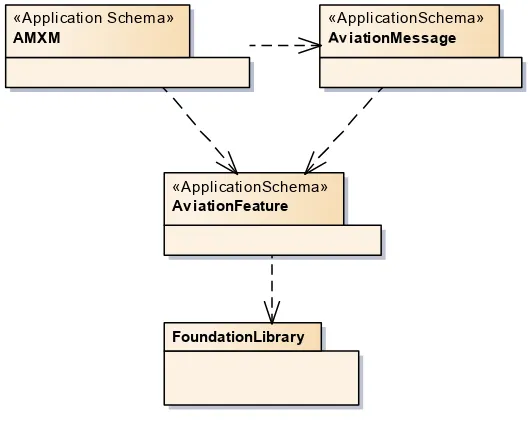Open Geospatial Consortium
Publication Date: 2015-10-30
Approval Date:2015-06-05
Posted Date:2015-05-06
Reference number of this document:OGC 15-026
Reference URL for this document: http://www.opengis.net/doc/PER/t11-aviation-feature-schema
Category: Engineering Report
Editor(s): Thomas Forbes, Alberto Olivares, Richard Rombouts
Testbed-11 Aviation Feature Schema Recommendations
Engineering Report
Copyright © 2015 Open Geospatial Consortium.
To obtain additional rights of use, visit http://www.opengeospatial.org/legal/.
Warning
This document is not an OGC Standard. This document is an OGC Public Engineering Report created as a deliverable in an OGC Interoperability Initiative and is not an official position of the OGC membership. It is distributed for review and comment. It is subject to change without notice and may not be referred to as an OGC Standard. Further, any OGC Engineering Report should not be referenced as required or mandatory technology in procurements.
Document type: OGC® Engineering Report Document subtype: NA
License Agreement
Permission is hereby granted by the Open Geospatial Consortium, ("Licensor"), free of charge and subject to the terms set forth below, to any person obtaining a copy of this Intellectual Property and any associated documentation, to deal in the Intellectual Property without restriction (except as set forth below), including without limitation the rights to implement, use, copy, modify, merge, publish, distribute, and/or sublicense copies of the Intellectual Property, and to permit persons to whom the Intellectual Property is furnished to do so, provided that all copyright notices on the intellectual property are retained intact and that each person to whom the Intellectual Property is furnished agrees to the terms of this Agreement.
If you modify the Intellectual Property, all copies of the modified Intellectual Property must include, in addition to the above copyright notice, a notice that the Intellectual Property includes modifications that have not been approved or adopted by LICENSOR. THIS LICENSE IS A COPYRIGHT LICENSE ONLY, AND DOES NOT CONVEY ANY RIGHTS UNDER ANY PATENTS THAT MAY BE IN FORCE ANYWHERE IN THE WORLD.
THE INTELLECTUAL PROPERTY IS PROVIDED "AS IS", WITHOUT WARRANTY OF ANY KIND, EXPRESS OR IMPLIED, INCLUDING BUT NOT LIMITED TO THE WARRANTIES OF MERCHANTABILITY, FITNESS FOR A PARTICULAR PURPOSE, AND NONINFRINGEMENT OF THIRD PARTY RIGHTS. THE COPYRIGHT HOLDER OR HOLDERS INCLUDED IN THIS NOTICE DO NOT WARRANT THAT THE FUNCTIONS CONTAINED IN THE INTELLECTUAL PROPERTY WILL MEET YOUR REQUIREMENTS OR THAT THE OPERATION OF THE INTELLECTUAL PROPERTY WILL BE
UNINTERRUPTED OR ERROR FREE. ANY USE OF THE INTELLECTUAL PROPERTY SHALL BE MADE ENTIRELY AT THE USER’S OWN RISK. IN NO EVENT SHALL THE COPYRIGHT HOLDER OR ANY CONTRIBUTOR OF
INTELLECTUAL PROPERTY RIGHTS TO THE INTELLECTUAL PROPERTY BE LIABLE FOR ANY CLAIM, OR ANY DIRECT, SPECIAL, INDIRECT OR CONSEQUENTIAL DAMAGES, OR ANY DAMAGES WHATSOEVER RESULTING FROM ANY ALLEGED INFRINGEMENT OR ANY LOSS OF USE, DATA OR PROFITS, WHETHER IN AN ACTION OF CONTRACT, NEGLIGENCE OR UNDER ANY OTHER LEGAL THEORY, ARISING OUT OF OR IN CONNECTION WITH THE IMPLEMENTATION, USE, COMMERCIALIZATION OR PERFORMANCE OF THIS INTELLECTUAL PROPERTY. This license is effective until terminated. You may terminate it at any time by destroying the Intellectual Property together with all copies in any form. The license will also terminate if you fail to comply with any term or condition of this Agreement. Except as provided in the following sentence, no such termination of this license shall require the termination of any third party end-user sublicense to the Intellectual Property which is in force as of the date of notice of such termination. In addition, should the Intellectual Property, or the operation of the Intellectual Property, infringe, or in LICENSOR’s sole opinion be likely to infringe, any patent, copyright, trademark or other right of a third party, you agree that LICENSOR, in its sole discretion, may terminate this license without any compensation or liability to you, your licensees or any other party. You agree upon termination of any kind to destroy or cause to be destroyed the Intellectual Property together with all copies in any form, whether held by you or by any third party. Except as contained in this notice, the name of LICENSOR or of any other holder of a copyright in all or part of the Intellectual Property shall not be used in advertising or otherwise to promote the sale, use or other dealings in this Intellectual Property without prior written authorization of LICENSOR or such copyright holder. LICENSOR is and shall at all times be the sole entity that may authorize you or any third party to use certification marks, trademarks or other special designations to indicate compliance with any LICENSOR standards or specifications.
This Agreement is governed by the laws of the Commonwealth of Massachusetts. The application to this Agreement of the United Nations Convention on Contracts for the International Sale of Goods is hereby expressly excluded. In the event any provision of this Agreement shall be deemed unenforceable, void or invalid, such provision shall be modified so as to make it valid and enforceable, and as so modified the entire Agreement shall remain in full force and effect. No decision, action or inaction by LICENSOR shall be construed to be a waiver of any rights or remedies available to it.
Contents
Page1 Introduction ... 1
1.1 Scope ... 1
1.2 Document contributor contact points ... 1
1.3 Future work ... 1
1.4 Foreword ... 2
2 References ... 3
3 Conventions ... 4
3.1 Abbreviated terms ... 4
3.2 UML notation ... 4
4 Testbed-11 Aviation Feature Schema Recommendations – Overview ... 5
4.1 Motivation and requirements ... 5
5 AFX Design Overview ... 6
5.1 AFX Foundation ... 6
5.2 AFX Components ... 7
5.2.1 AFX Conceptual Model (UML) ... 7
5.2.1.1 AviationMessage ... 9
5.2.1.2 AviationFeature ... 10
5.2.1.3 AviationFeatureState and AviationFeatureTransition ... 12
5.2.2 AFX Physical Model (XSD) ... 15
5.2.2.1 aviationMessage.xsd ... 15
5.2.2.2 aviationFeature.xsd ... 15
6 AMXS AFX Implementation Example ... 16
6.1 AMXS AFX Implementation XML Example ... 18
6.2 AMXS AFS Implementation WFS Example ... 19
7 AFX Assessment and Discussion ... 21
7.1 Compliance to GML Application Schema Encoding Rules ... 22
7.2 Developing a Format for Portrayal ... 26
7.2.1 Profiling AIXM ... 26
7.2.2 Profiling AFX with GML Simple Features Profile ... 28
7.2.2.1 GML Simple Feature Profile ... 28
7.2.3 Geometry in AFX Implementations ... 31
7.2.3.1 Generalised Geometries ... 33
7.2.4 Temporality in AFX Implementations ... 34
7.2.5 Change Management ... 35
8 Observations and Recommendations ... 36
8.1 Observations ... 36
8.2 Recommendations ... 38
Figures
PageFigure 4 AviationFeatureState class from AFX conceptual model. 13
Figure 5 AviationFeatureTransition class from AFX conceptual model. 14
Figure 6 Example of inheritance from Airport Mapping AM_Package to AFX
AviationMessage. 16
Figure 8 Example of AMXS AFX implementation visualized in QGIS via WFS 1.1. 20
Figure 9 Physical implementations of the AIRM for ATM application domains. 21
Figure 10 Overview of the aviation feature schemas and their dependencies. 22
Figure 11 XML schema specific datatypes defined in Aerodrome Mapping schema. 23
Figure 12 Model of a choice between a state and a transition in the Aviation Feature
Schema. 24
Figure 13 Example of complex airspace (using ArcByCenterPoint and GeodesicString) as
encoded in AIXM 5.1. 31
Figure 14 Example of complex airspace geometry as encoded in AIXM 5.1. 32
Tables
Page
Table 1 Advantages and disadvantages of profiling AIXM for portrayal and mapping. ... 26
Table 2 GML packages included in GML versions and profiles. ... 28
Table 3 Capabilities of Level 0, 1 and 2 of the GML Simple Features Profile. ... 30
Table 4 AFX Observations. ... 36
Abstract
Developed by EUROCONTROL, the Aviation Feature Schema (AFX) is a template for application schemas to implement by adding their operational attributes. For example, the Airport Mapping format can be implemented by extending AFX. The AFX defines concepts of geometry and temporality through predefined classes and properties. Therefore, these elements need not be redefined by application schemas. This means implementations of the AFX abide by the same structure, therefore aiding interoperability and allowing the rapid development of schemas. The AFX schema is designed to be generic and easily reusable and it is not intended to replace the standard aviation models such as WXXM and AIXM.
This Engineering Report assesses the suitability of the AFX as a template for lowering the GIS entry level for aviation data, providing recommendations of suitability and areas of improvement. The report is aimed at system and client developers that shall use AFX.
Business Value
With the goal of lowering the GIS-entry level in aviation the AFX model focuses on portrayal of aviation data, including visualization and mapping of aviation related features. This Engineering Report assesses the suitability of the AFX as a model for the portrayal of aviation data, provides recommendations for improvement and reports on the overall quality of the model.
Existing aviation data exchange formats, such as AIXM, IWXXM and FIXM, focus on the system-to-system exchange of aviation data. System-to-system exchange of information introduces complexities that should not impact the end-user wanting to visualize and map the data. AFX does not seek to replace existing aviation models. Instead AFX focuses on portrayal by promoting mapping and visualization of aviation related features that are important for improved situational awareness.
Keywords
Testbed-11
1 Introduction
1.1 Scope
This OGC® Engineering Report assesses the suitability of the Aviation Feature Schema (AFX) for portrayal, provides recommendations for improvement and reports on the quality of the model. This Engineering Report:
Provides a description of the AFX.
Assesses the suitability of the AFX in a wider context. Reports on the quality of the AFX.
Proposes recommendations for AFX improvements.
1.2 Document contributor contact points
All questions regarding this document should be directed to the editor or the contributors:
Name Organization
Alberto Olivares Snowflake Software
Richard Rombouts Snowflake Software
Thomas Forbes Snowflake Software
Alexis James Brooker Snowflake Software
Rosie Partington Snowflake Software
Johannes Echterhoff interactive instruments GmbH
1.3 Future work
Improvements to this document are desirable as the OGC community continues its efforts to advance interoperability using OGC and ISO standards within the aeronautical domain. The observations and recommendations raised in section 8 should be addressed in follow-up activities; these include the following:
Examination of the AFX temporality concept.
Assess impact of licensing terms on AFX uptake and implementation.
Further assessment of AFX compliance to ISO/OGC modeling and encoding rules best practice.
1.4 Foreword
Attention is drawn to the possibility that some of the elements of this document may be the subject of patent rights. The Open Geospatial Consortium shall not be held responsible for identifying any or all such patent rights.
2 References
The following documents are referenced in this document. For dated references, subsequent amendments to, or revisions of, any of these publications do not apply. For undated references, the latest edition of the normative document referred to applies. OGC 07-036, OpenGIS Geography Markup Language (GML) Encoding Standard
OGC 09-025r1, OpenGIS Web Feature Service 2.0 Interface Standard
OGC 05-033r9, GML Simple Features Profile
OGC 10-100r3, Geography Markup Language (GML) simple features profile (with Corrigendum)
OGC 12-028, Guidance and Profile of GML for use with Aviation Data
OGC 06-121r3, OGC® Web Services Common Standard
OGC 15-024, Aviation Guidance Using SBVR Engineering Report
ISO 19115:2003 Geographic Information – Metadata
SESAR 08.01.03 ATM Information Reference Model (AIRM 2.3.1)
AIXM – Temporality Model v1.0, online at:
http://www.aixm.aero/public/standard_page/download.html
Aviation Feature Schema (AFX) Manual, version 2.0.1 – draft
3 Conventions
3.1 Abbreviated terms
AFX Aviation Feature Schema
AIRM ATM Information Reference Model
AIXM Aeronautical Information Exchange Model AMCM Airport Mapping Conceptual Model AMXM Airport Mapping Exchange Model AMXS Airport Mapping Exchange Schema COI Community Of Interest
COTS Commercial Off The Shelf
FIXM Flight Information Exchange Model FOSS Free and Open-Source Software GIS Geographic Information System GML Geography Markup Language
ICAO International Civil Aviation Organization ISO International Organization for Standardization OCL Object Constraint Language
OGC Open Geospatial Consortium OMG Object Management Group
OWS OGC Web Services
SWIM System Wide Information Management UGAS UML to GML Application Schema UML Unified Modeling Language
WXXM Weather Information Exchange Model WFS Web Feature Service
XML Extensible Markup Language
3.2 UML notation
4 Testbed-11 Aviation Feature Schema Recommendations – Overview
Developed by EUROCONTROL, the AFX is a template for implementing application schemas by adding their operational attributes. For example, the Airport Mapping format can be implemented by extending AFX. The AFX defines concepts of geometry and temporality through predefined classes and properties. Therefore these elements need not be redefined in application schemas that use AFX. This means implementations of the AFX abide by the same structure. This approach enhances interoperability and allows the rapid development of new schemas. The AFX schema is designed for aviation data portrayal and to be generic and easily reusable. AFX is not intended to replace the standard aviation exchange models, for instance Aeronautical Information Exchange Model (AIXM), Weather Information Exchange Model (WXXM) and Flight Information Exchange Model (FIXM).
This Engineering Report assesses the suitability of the AFX as a template for lowering the GIS entry-level for aviation data which aims to remove complexities of system-to-system exchange formats such as AIXM and WXXM for aviation data portrayal and mapping, providing recommendations of suitability and areas of improvement. The report is aimed at system and client developers that use AFX.
4.1 Motivation and requirements
The Aviation Feature Schema (AFX) format is designed primarily to aid reusability and to be generic. The AFX design is driven by the purpose of portrayal and mapping - not to replace existing aviation exchange standards such as WXXM, FIXM and AIXM. AFX acts as a template for application schemas to implement by adding operational attributes. The motivation for this OGC Engineering Report is to, (1) assess the suitability of the AFX schema for portrayal (mapping and visualization) of aviation data in simple GIS clients, (2) maximize interoperability of AFX, and (3) make exchange, display and manipulation as easy as possible.
5 AFX Design Overview
5.1 AFX Foundation
The AFX is comprised of two components, (1) a UML conceptual model, and (2) an XML schema. By extending, using the AFX template, an application schema may inherit the structure as predefined by the classes and properties within AFX. For example, the concept of temporality and geometry are predefined within AFX. Therefore application schemas do not need to redefine these concepts. By inheriting a common structure to all AFX implementations the AFX enhances interoperability.
The AFX is based on a foundation of standards from the ISO/TC 211 series, including ISO191361 (GML) and ISO19115 (Metadata). (see Figure 1). GML serves as a modeling
and encoding language for geographic systems as well as an open interchange format for geographic transactions on the Internet. By extending and reusing types from GML, AFX presents multiple benefits that are presented later in the document. ISO19115 (and ISO19139) is the best practice for geospatial metadata, allowing a description of the data to be provided alongside the data.
1 The Geography Markup Language (GML), an XML grammar defined by the OGC, was adopted as an International
5.2 AFX Components
The AFX is comprised of two components: 1. AFX conceptual model (UML). 2. AFX physical model (XSD).
These components provide a structure that should be adopted by the application schemas that implement the AFX format. The structure inherited by implementations of AFX is defined within the classes and properties within the UML and XSD.
5.2.1 AFX Conceptual Model (UML)
The AFX conceptual model is represented in Unified Modeling Language (UML) format. The AFX conceptual model UML includes packages containing the foundation standards, as discussed in Section 6.1; these include the ISO/TC 211 package which provides ISO standards covering areas of digital geographic information and geomatics such as the Geography Markup Language (GML).
Three major components exist within the AFX conceptual model: 1. AviationMessage
2. AviationFeature
3. AviationFeatureState & AviationFeatureTransition
Throughout the AFX conceptual model, classes are colour-coded to represent the following:
Orange - An AFX class.
5.2.1.1 AviationMessage
The AviationMessage component extends the GML AbstractFeatureCollection; this
enables a collection of aviation features to be defined within a single message. The
AviationMessage is associated with AviationFeature with a multiplicity of
optional-to-many (‘0..*’). This relationship enables associations to zero to many AviationFeatures
(Figure 2).
The AviationMessage component provides a similar function to the AIXMBasicMessage
component of the AIXM conceptual model.
The AviationMessage class also offers the option to include ISO 19115 compliant
5.2.1.2 AviationFeature
The AviationFeature class represents an abstraction of a real world phenomenon. The
AviationFeature class is an abstract class that is derived from ‘gml:AbstractFeatureType’;
application schemas implementing AFX will populate this class. For example, when implementing the Airport Mapping format by extending AFX, feature types include AM_AerodromeReferencePoint, AM_TaxiwayElement and AM_ApronElement.
The AviationFeature is associated with the TM_Period class (GML) giving the
AviationFeature class a property named ‘lifeTime’. The ‘lifeTime’ property allows the storage of the feature lifetime, for example from initial feature commissioning to feature decommissioning; this is done using a GML TimePeriod. The lifetime property will be a common property of all features extending the AviationFeature class.
The AviationFeature may contain an unlimited number of AviationFeatureStates and/or
AviationFeatureTransitions; these are discussed further in the following section (see
Figure 3).
Similar to the AviationMessage class, the AviationFeature class also offers the option to include ISO 19115 compliant metadata in-situ within the data or externally referenced. The ISO 19139 specification provides an XML schema implementation profile derived from the ISO 19115 abstract metadata specification.
class Av iationMessage
Will be replaced by concrete classes in the XSD
Metadata
«FeatureType»
FeatureTypes:: AviationFeatureState
It is rered that AeronauticalFeatureStates can be
included inessaeithout being contained in a + boundedBy: GM_Envelope [0.1]
«XSDsimpleType»
XMLSchemaDatatypes:: anyURI
«type»
gmlBase::AbstractGML + description: CharacterString [0.1] + descriptionReference: URI [0.1] + identifier: ScopedName [0.1] + name: GenericName [0.*]
class Av iationFeature
Time varying feature properties ill be implemented by concrete classes that inherit from this class.
A state contains all of the properties as they ill be during talidTime.
The move beteen States is handled by Transitions hich can be derived from comparing to states).
A Transaction is valid at a time instant.
It has to contain all of the same data as a state as anything can be changed. «FeatureType»
feature::AbstractFeature boundedBy: GM_Envelope [.1]
«type»
gmlBase::AbstractGML description: CharacterString [.1] descriptionReference: URI [.1] identifier: ScopedName [.1] name: GenericName [.]
5.2.1.3 AviationFeatureState and AviationFeatureTransition
Each AviationFeature may contain multiple AviationFeatureStates and/or
AviationFeatureTransitions. Both AviationFeatureState and AviationFeatureTransition
classes are abstract; the application schema implementing AFX will populate the classes as a specialization. These classes will contain time-varying feature properties, for example an aerodrome’s name. An explanation of the class differences is shown below.
AviationFeatureState
A feature ‘state’ is a time period; throughout the time period of a single feature state the feature properties remain the same (see Figure 4). If a feature property changes, a new feature state is instantiated and all feature properties, including those that did not change are copied to the new feature state. These feature states do not overlap. The time instant when a feature state changes is called a ‘transition’, a description of feature transitions is provided later in the document.
The AviationFeatureState is associated with multiple properties:
1. afx:validTime – the GML time period for which the feature state is valid for. 2. afx:geometry – the GML geometry (limited to point, linestring and polygon) for
the feature state.
3. afx:limits – upper and lower elevation limits of the feature.
4. afx:metadata / afx:metadataLocation – the associated ISO metadata.
5. gml:boundedBy – a GML envelope describing the minimum bounding box
encompassing the feature.
6. gml:identifier – a feature identifier.
7. gml:description / gml:descriptionReference – feature description, or reference to feature description.
8. gml:name – feature name.
All AviationFeatureState properties are optional. This is to ease validation of adaptation
Figure 4 AviationFeatureState class from AFX conceptual model.
AviationFeatureTransition
A feature ‘transition’ is a time instant; a feature transition occurs when a feature state changes. The feature transition may contain all the feature properties contained within the feature state (see Figure 5).
The AviationFeatureTransition is associated with multiple properties:
1. afx:transitionTime – the GML time instant for which the feature transition is valid for.
2. afx:geometry – the GML geometry (limited to point, linestring and polygon) for the feature transition.
3. afx:limits – upper and lower elevation limits of the feature.
4. afx:metadata / afx:metadataLocation – the associated ISO metadata.
class Av iationFeatureState
choice to very basic geometry types boundedBy: GM_Envelope [!.1]
«type»
5. gml:boundedBy – a GML envelope describing the minimum bounding box encompassing the feature.
6. gml:identifier – a feature identifier.
7. gml:description / gml:descriptionReference – feature description, or reference to feature description.
8. gml:name – feature name.
All AviationFeatureTransition properties are optional. This is to ease validation of
adaptation and implementation of AFX. For example, an application schema implementing AFX may not be concerned with the metadata or limits of a particular feature. By being optional, the exclusion of these unwanted properties is permitted.
Figure 5 AviationFeatureTransition class from AFX conceptual model.
class Av iationFeatureTransition
choice to very basic geometry types : boundedBy: GM_Envelope [@A.1]
«type»
5.2.2 AFX Physical Model (XSD)
The AviationFeature and AviationMessage components of the AFX model have
corresponding XML schemas (XSDs) based on GML. The schemas provide a physical implementation of the conceptual UML model.
To future proof the AFX XSDs two different namespaces are used for each schema. As such, the schemas could evolve independently down different paths.
5.2.2.1 aviationMessage.xsd
The aviationMessage.xsd schema declares itself a GML FeatureCollection element by extending the AviationMessage element from gml:AbstractFeatureCollection. The AviationMessage element may contain any number of GML features as members. A similar function is observed within AIXM and the AIXMBasicMessage element.
The AviationMessage may also be accompanied with embedded or externally referenced metadata using the metadata and metadataLocation elements. Embedded metadata conforms to ISO 19115 Geographic Information Metadata standards.
5.2.2.2 aviationFeature.xsd
6 AMXS AFX Implementation Example
Developed by EUROCONTROL, the Airport Mapping Exchange Schema (AMXS) is an exchange format for airport data. The AMXS is an XML schema designed to implement the Airport Mapping Exchange Model (AMXM). The AMXS defines 33 feature types for airport mapping. By extending from AFX, the following section demonstrates an example of how the AMXS can implement AFX.
The Airport Mapping format AM_Package inherits from the AFX AviationMessage class (Figure 6).
Figure 6 Example of inheritance from Airport Mapping AM_Package to AFX AviationMessage.
Each feature type within the Airport Mapping format inherits from the AviationFeature
AFX class. Ultimately the Airport Mapping features inherit from the
AviationFeatureState, various properties specific to the Airport Mapping format are
added to the AviationFeatureState (Figure 7). class AM_PWYZW[es
«FeatureType»
\M_PWYZW[e AbstractFeature
«FeatureType»
class AerodromeMappingFeatureSchemaEx]^ples
Aerodrome Mapping Feature Schema E`amples
Aviation Feature Schema gMqgrrestingGearLocationltate c geoline: GMrstneString c idthr: idthrType gM_Constructiongrk]ltate c geopoly: geopolyType
6.1 AMXS AFX Implementation XML Example
An XML sample generated from the Airport Mapping application schema when implementing AFX is shown below. An AMXS AM_TaxiwayElement feature is presented.
<amxs:AM_TaxiwayElement gml:id="LOCAL_ID_0">
<gml:identifier codeSpace="urn:uuid:">cf10b08e-3cd0-4ac3-be6d-ec423bac7a90_MODIFIED</gml:identifier>
<afx:lifeTime>
<gml:TimePeriod gml:id="LOCAL_ID_1">
<gml:beginPosition>2015-01-01T10:00:00.000</gml:beginPosition> <gml:endPosition indeterminatePosition="unknown"/>
</gml:TimePeriod> </afx:lifeTime> <afx:state>
<amxs:AM_TaxiwayElementState gml:id="LOCAL_ID_2"> <afx:validTime>
<gml:TimePeriod gml:id="LOCAL_ID_3">
31.964228391727417 52.37514852880121 31.963669143754903 52.37413010408671 31.963484475292006 52.37403221201539 31.963411376762416 52.37398348915221 -31.963265930776455 52.374114061066535 -31.960971595710426</gml:posList> </gml:LinearRing>
</gml:exterior> </gml:Polygon> </afx:geometry>
<amxs:interp>Baseline</amxs:interp> <amxs:feattype>taxiway</amxs:feattype> <amxs:source>Eurocontrol</amxs:source> <amxs:idlin>NORMAL</amxs:idlin>
<amxs:idarpt>EADD</amxs:idarpt> </amxs:AM_TaxiwayElementState> </afx:state>
</amxs:AM_TaxiwayElement> </gml:featureMember>
</amxs:AM_Package>
6.2 AMXS AFS Implementation WFS Example
As the AFX and application schemas that implement the AFX extend GML, the OGC/ISO Web Feature Service (WFS) interface standard can be used as a request-response interface for AFX data. The design of the AFX is founded upon the principle of interoperability and ease of use. As a result the AFX has been designed to account for limitations of WFS 1.1.0. The AFX uses a restricted set of GML 3.2 constructs and allows ISO metadata to be included either in situ within the messages, or referenced to an external location.
The AMXS implementation of AFX is able to be served via a WFS. An example request for an AM_TaxiwayElement feature is provided below.
http://[host]:[port]/[wfsName]/[servletURL]?service=wfs&version=1.1.0 &request=GetFeature&typename=AM_TaxiwayElement
Many GIS tools are able to connect to a WFS instance to visualize and map data responses. Figure 8 illustrates the portrayal of airport mapping information in a FOSS2
(QGIS v2.8.1).
Figure 8 Example of AMXS AFX implementation visualized in QGIS via WFS 1.1.
7 AFX Assessment and Discussion
The ATM Information Reference Model (AIRM) aims to provide a conceptual blueprint for physical implementations in order to encourage semantic interoperability and common understanding. The AIRM is a consolidated logical UML model used as a common reference for civil, military and civil-military information constructs, relevant to the different domain applications within ATM currently in the SESAR development phase.
Mature aviation data exchange formats exist as physical implementations of the conceptual AIRM, for example, AIXM, WXXM and FIXM (Figure 9). These physical implementations have been designed primarily for the exchange of aeronautical, weather and flight information between systems using XML-based encodings. These aviation data models are inherently complex due to the complex and often transient real-world phenomena that they represent, coupled with the business need for system-to-system data transfer.
Figure 9 Physical implementations of the AIRM for ATM application domains.
removing the need for the application schema that implements AFX to redefine these concepts. Ultimately the AFX promotes rapid development of schemas by allowing different applications schemas to adopt the same overarching structure, thereby aiding interoperability.
As a format for portrayal and mapping, the AFX is designed with several key principles in mind, (1) to be exchanged via web services, for example via the OGC/ISO Web Feature Service (WFS) interface standard, and (2) to lower the GIS entry-level in aviation so that custom-built tools are not required to map and portray the data, as often observed with more complex aviation models such as AIXM.
7.1 Compliance to GML Application Schema Encoding Rules
The Aviation Feature Schema (AFX) as well as the Aerodrome Mapping schema (AMXM), which is an application schema built on top of AFX, have been analyzed in Testbed 11 (see Figure 10).
Figure 10 Overview of the aviation feature schemas and their dependencies.
The review of the conceptual schemas of AFX and AMXM as well as their XML implementation schemas revealed that they do not fully comply with the GML application schema encoding rules.
The schemas use stereotypes that are not defined for GML application schema, such as <<XSDsimpleType>>, <<XSDcomplexType>>, <<XSDrestriction>>, <<deprecated>>, and <<Choice>> (see Figure 11).
«Application Schema»
AMXM
«ApplicationSchema»
Av iationFeature
FoundationLibrar~
«ApplicationSchema»
Figure 11 XML schema specific datatypes defined in Aerodrome Mapping schema.
Some of these stereotypes could be mapped to well-known stereotypes or ignored altogether. For example, <<Choice>> could be mapped to <<union>>.
Especially the use of the <<XSD…>> stereotypes is problematic. They are used to specify datatypes, with the value type as well as minimum and maximum value range where appropriate. This modeling approach pollutes the conceptual schema with implementation details; in this case the conceptual schema is heavily geared towards an XML Schema implementation. This is an issue whenever other implementation schemas, for example a JSON or database schema, are being derived from the conceptual schema. The issue could easily be avoided by following ISO/OGC best practices on application schema modeling. One could define <<dataType>> classes that have a “value” property of the appropriate type (e.g. “CharacterString”, “Real”, “Boolean”, “Integer”) and constraints (e.g. declared using OCL) that specify allowed value ranges.
That the ISO/OGC best practices on application schema modeling are not followed in aviation feature schemas is a general issue for all software components that rely on compliance of schemas and actual data with these best practices. This requires customization and can be problematic with respect to interoperability with ISO/OGC standards based software.
There are more examples of the aviation feature schemas not following the GML application schema encoding rules.
The conceptual model does not define the tagged value “inlineOrByReference” for the properties of a class. Application schema processing software such as ShapeChange that
«XSDcomplType» AMXM AttributeTypes::geopntType
«type»
Geoetric pr it e::GM_Point
position: Directosition
beari M_ayCenterlinePointtate
read the conceptual schema, for example to derive Schematron code, therefore assumes that the default defined for this tagged value applies. The default is “inlineOrByReference”3. However, in the AFX XML Schema the encoding is just
“inline” (example: property “state” in class FeatureContentChoice). This can lead to unexpected results and even to wrong results. The issue could easily be resolved by declaring the tagged value “inlineOrByReference” in the conceptual model whenever the XML encoding deviates from the encoding that results from the default for this tagged value.
Another example is the modeling of <<Choice>> types. A <<Choice>> resembles a <<union>> type, which is covered by the GML application schema encoding rules. However, in the conceptual schema of AFX no name is assigned to the property that is of the choice/union type (see Figure 12).
Figure 12 Model of a choice between a state and a transition in the Aviation Feature Schema.
This is not compliant with GML application schema encoding rules. It is even different to how <<choice>> types are modeled in AIXM4. From a practical perspective, this can be
an issue for example when formulating SBVR constraints. Software like the
3 The other enumeration values defined for the “inlineOrByReference” tagged value are “inline” and “byReference”. 4 The Aviation community appears to use modeling and encoding rules that are not only different to those defined by
ISO/OGC but also to each other.
AbstractFeature
«FeatureTy...
AviationFeature
«Choice»
Av iationFeature:: FeatureContentChoice
AbstractFeature
«FeatureType»
AviationFeatureState
AbstractFeature
«FeatureType»
AviationFeatureTransition
7.2 Developing a Format for Portrayal
A format for portrayal of aviation data could be developed using a number of methods. Firstly, a top-down approach could be undertaken, whereby a mature aviation exchange standard is adopted and repurposed for the function of portrayal. Or secondly, a bottom-up approach could be undertaken, whereby an aviation data portrayal standard is developed from scratch and restrictions are imposed via profiling. The former approach is investigated by assessing the plausibility of profiling AIXM specifically for the purpose of data portrayal. The latter approach is investigated by assessing the application of a profile to the existing AFX.
7.2.1 Profiling AIXM
AIXM, although dissimilar to AFX with respect to model complexities and use cases, could be used as a foundation for producing a similar result to the AFX model by using profiling methods.
By profiling AIXM, a controlled subset of the AIXM model for representing real-world aviation phenomena could be produced; profiling AIXM in this way would make interoperability and wider implementation more achievable. Profiling the AIXM model allows AIXM to be repurposed from its original use case of ‘system-to-system exchanges’, to ‘exchange for portrayal and mapping’ of aviation data. The use of AIXM profiles to simply represent aviation data is already being investigated; however in some cases new schemas have been created, for example the Simple Aeronautical Features (SAF) schema used in IWXXM to represent aeronautical features such as aerodromes and runways.
Table 1 presents advantages and disadvantages of AIXM profiling to produce a data format for aviation data portrayal and mapping.
Table 1 Advantages and disadvantages of profiling AIXM for portrayal and mapping.
Advantages Disadvantages
The same exchange model is used; therefore existing AIXM systems would support this.
The complexity of the temporality model and change management mechanism would remain.
A simplified AIXM model would enable wider GIS software support.
Retain the same structural encodings of concepts, but use cases are very different.
Multiple features types already defined within AIXM.
7.2.2 Profiling AFX with GML Simple Features Profile
Alternatively to profiling AIXM, AFX implementations could be subject to GML profile compliance. Currently, the implementation of AFX is flexible, allowing the end-user to add operational attributes with varying complexities. AFX implementations could be restricted to a subset of the XML-schema and GML scope which would ensure a vendor’s implementations remained interoperable between clients, and usable with simple GIS tools.
The profile itself would define strict rules that adhere to common GIS modeling approaches, including the structure and types used. Numerous AFX implementations may be developed that adhere to the profile while retaining interoperability between vendors and applications.
Features must be defined using a well-known and simplified feature model that can be represented using only the GML and XML-schema components defined within the profile.
7.2.2.1 GML Simple Feature Profile
Table 2 presents a comparison of the GML packages included within multiple versions of the GML specification, the GML Simple Features Profile and the AFX Implementation as presented in section 6.
Table 2 GML packages included in GML versions and profiles.
GML Packages GML
5 It is worth noting, ground-based routing would not be possible due to the lack of support for topology within the
GML Packages GML 2.1
GML 3.1
GML 3.2
GML Simple Feature Profile
AFX Implementation
Example
Coordinate Reference Systems üü üü
Observations, values, units of measure üü üü
Default Styling üü
As presented by Table 2, the AFX implementation presented in section 6 uses the same GML packages as the GML Simple Features Profile; therefore the AMXS AFX implementation could adhere to the GML Simple Features Profile.
The AMXS was designed with interoperability and compatibility in mind. The AMXS design is intended to make the implementations compatible with third-party GML-compliant applications, and therefore enable end users to use the AMXS data in Geographic Information Systems (GISs).
Implementations of AFX that do not use application schemas that have been designed with portrayal and simplicity in mind, such as AIXM, will inherit complexities from those application schemas.
Three levels of compliance to the GML Simple Features Profile are defined; Table 3 presents the level compliance criteria.
Table 3 Capabilities of Level 0, 1 and 2 of the GML Simple Features Profile.
Level 0 (SF-0) Level 1 (SF-1) Level 2 (SF-2)
Restricted set of built-in non-spatial
property type Yes
1 Yes1 No
Restricted set of spatial property types Yes2 Yes2 Yes2
Use of nillable and xsi:nil No Yes Yes
User-defined property types No Yes Yes
Cardinality of properties 0 or 1 0..unbounded 0..unbounded
Non-spatial property values references Yes3 Yes3 Yes
Spatial property values references Yes3 Yes3 Yes
1 String, integer, measurement, date, real, binary, Boolean, URI.
2 Point, Curve (LineString), Surface (Polygon), Geometry, MultiPoint, MultiCurve, MultiSurface,
MultiGeometry.
3
In level 0 and 1, remote values for properties are supported only through the use of the type gml:ReferenceType. The more generalized GML property-type pattern allowing mixed inline and by-reference encoded property values within the same instance document is disallowed.
In order to maximize interoperability and GIS entry level for aviation data, SF-0 should be followed.
Compliance level SF-0 is the most restrictive, SF-1 less restrictive and SF-2 the least restrictive whilst still abiding to the GML Simple Features Profile.
Implementations of AFX will require multiple instances of properties within a single feature due to the AviationFeatureState and AviationFeatureTransition properties; there SF-0 is not applicable.
Compliance level SF-1 does not allow the use of inline and by-reference property values within the same instance document. As AFX allows ISO metadata to be included via inline or by-reference within the same instance document, compliance level SF-1 is too restrictive for AFX implementations to adhere to.
Whilst AFX implementations would require use of restricted capabilities in 0 and SF-1, SF-2 allows restriction to be placed on AFX implementations, but does not restrict required capabilities.
7.2.3 Geometry in AFX Implementations
While the GeometryChoice element of the AFX model restricts a feature’s geometry to be encoded as a Point, LineString or Polygon, complex representations of geometries exist within other aviation data models. For example, the AIXM 5.1 model allows complex geometry types such as ArcByCenterPoint, CircleByCenterPoint and GeodesicString, see Figure 13 and Figure 14.
Complex geometry types such as those noted are unlikely to be supported out-the-box by most GIS tools and for these complex geometries to be encoded in AFX implementations, geometries must first undergo simplification, densification and/or generalization.
Figure 13 Example of complex airspace (using ArcByCenterPoint and GeodesicString) as encoded in AIXM 5.1.
…
<aixm:horizontalProjection>
<aixm:Surface srsName="urn:ogc:def:crs:OGC:1.3:CRS84" gml:id="id_37"> <gml:patches>
<gml:PolygonPatch> <gml:exterior> <gml:Ring>
<gml:curveMember>
<gml:Curve gml:id=" id_38"> <gml:segments>
<gml:pos>7.251956389 47.1243625</gml:pos>
Figure 14 Example of complex airspace geometry as encoded in AIXM 5.1.
AFX implementations offer the flexibility for a vendor to forgo the optional AFX defined geometry element, and to define their own geometries. Without restriction on usable geometry types a vendor may define a complex geometry type that may be incompatible simple GIS tools. By AFX implementations adhering to the GML Simple Feature Profile, AFX implementations would be restricted to the following geometry types:
Point
Surface (Polygon) Geometry
Multipoint MultiCurve MultiSurface MultiGeometry
The benefit of restricting usable geometry types is to foster maximum interoperability of the geospatial data; support for these simple geometry types is offered by many off-the-shelf GIS tools.
The AFX implementation example using AMXS as presented in section 6 utilizes the following geometry types, (1) Point, (2) LineString, and (3) Polygon. This implementation example would therefore comply with the GML simple features profile.
7.2.3.1 Generalised Geometries
7.2.4 Temporality in AFX Implementations
Many aviation data exchange models include complex representations of time; for example AIXM is built upon an exhaustive temporality model; this complexity is required due to the dynamic and often transient nature of the real-world phenomena the model represents. For example, the AIXM temporality model is capable of modeling permanent and temporary change, intrinsic change and feature states at points in time. The AFX model defines a temporality concept that is inherited by the application schema that implements AFX. The temporality model consists of two major temporal components, (1) feature states, and (2) feature state transitions (Figure 15). The temporality model adopted by AFX describes feature states and transitions. A transition is a change in one or more feature properties. A feature state is a feature property set valid over a period of time. These temporal components are similar to AIXM ‘BASELINE’ and ‘PERMDELTA’ time slices. The AFX temporality model lacks a concept of temporary change, intrinsic change or feature states at points in time.
The differences between the complex temporality model of AIXM and the less complex representation of temporality in AFX results from the differing business needs of the models. Since AFX implementations are designed for portrayal and mapping of aviation data, a comprehensive temporality model is not required.
The AFX models the feature lifetime element outside of the temporality model (unlike AIXM) so when modeling historic data, this structure is acceptable. However, when exchanging future data, situations where the planned feature lifetime may alter. Therefore the feature lifetime element should be incorporated within the temporality model.
7.2.5 Change Management
AFX does not include a method of version control or change management. For example, within AIXM’s exhaustive temporality model the ‘sequenceNumber’ and ‘correctionNumber’ elements allow the vendor to submit updates and corrections to time slices.
An AFX implementation may construct a version of change management itself, by adding elements that allow a state or transition to be version controlled. For instance, similar constructs to ‘sequenceNumber’ and ‘correctionNumber’ could be instantiated within the AviationFeatureState and AviationFeatureTransition classes.
8 Observations and Recommendations
8.1 Observations
This section provides observations based on the overall design and technical implementation analysis of the AFX as discussed in sections 5, 6 and 7. These observations are presented in Table 4.
Table 4 AFX Observations.
Observation
Number Description Impact
1.
AFX implementations do not restrict elements that can be inherited from application schema implementations.
Complex geometries, types and temporality models could be introduced to AFX implementations - these may be incompatible with COTS GIS clients.
2.
AFX is licensed under BSD license template as provided by the Open Source Initiative.
May have Intellectual Property Right implications for those implementing AFX.
3.
There is no constraint to say that there must be at least one AviationFeatureState
or AviationFeature in an AviationMessage
element.
An AviationMessage containing zero
AviationFeatureStates or AviationFeatures would be
a valid message.
4.
The lifeTime element is not static when
considering future data, therefore should reside within the temporal model.
The lifetime of a feature is a dynamic element and may change throughout time, particularly when considering future data. This should be modeled
within the AviationFeatureState and
AviationFeatureTransition classes.
5.
Unlike other aviation related exchange models, for example AIXM, FIXM and WXXM, the AFX does not extend the AIRM.
For interoperability reasons it would be recommended to use the AIRM reference model to extend domain specific application schemas from.
6.
The AFX is not aligned with the Simple Aeronautical Features schema within IWXXM.
Risk of non-interoperable implementations despite the similarity of the logical entities encoded in the physical schema.
7.
Maximum GIS support would be reached through GML Simple Features Profile compliance level SF-0 adherence.
GML subset is smaller than the GML Simple Features Profile; therefore GML support by GIS client would be minimal.
However current, temporal and metadata requirements do not allow AFX implementations to reach the SF-0 compliance level.
8. Geometry scales could be created
depending on GIS use cases.
GIS use cases for AFX implementations need be developed.
9.
The review of the conceptual schemas of AFX and AMXM as well as their XML implementation schemas revealed that they do not fully comply with the GML application schema encoding rules.
Observation
Number Description Impact
10.
The aviation feature schemas have been implemented using AFX specific modeling and encoding rules, rather than following ISO/OGC best practices.
In principle a community of interest (COI) can always define its own modeling and encoding rules. This is especially true if existing standards do not cover or are – or appear to be – incompatible with
specific requirements of the COI6. However, this does not seem to be the case here.
6 The modeling and encoding of dynamic features to meet the needs of the aviation community, for example, is not yet
covered by ISO/OGC standards. Thus specific rules had to be developed by the Aviation community to model and encode AIXM (even though some of the basic rules, for example to model properties and unions, could have been adopted from ISO/OGC standards).
8.2 Recommendations
Based on the technical analysis (sections 5 and 7), observations (section 8) and implementations (section 6) of the AFX, this section provides suggested recommendations and improvements for the AFX (Table 5).
Table 5 AFX Recommendations.
Recommendation
Number Recommendation
1.
Utilize GML profiling techniques to restrict implementations of AFX to a simple subset of the GML specification, therefore ensuring compliance with simple GIS clients.
2.
Specify a minimum occurrence of the AviationFeatureState,
AviationFeatureTransition and AviationFeature elements.
By differentiating the AviationFeatureState and AviationFeatureTransition
elements, it has forced a minimum occurrence of ‘0’, however by defining a generic element with a property that defines whether the it refers to a feature state or transition would allow a minimum occurrence of ‘1’ to be set.
3.
Move the lifeTime element from outside of the temporal concept to within the feature state or transition elements as the feature lifetime may alter throughout a feature’s lifetime.
4.
Assess the impact of the AFX being licensed under the BSD license template as provided by the Open Source Initiative. IPR of implementations may impact uptake and implementation of AFX.
5.
The aviation feature schemas have been implemented using AFX specific modeling and encoding rules, rather than following ISO/OGC best practices. A more detailed analysis of AFX modeling requirements should be performed, to determine if any of them cannot be covered by ISO/OGC modeling and encoding rules. If it turns out that this is not the case, in other words that ISO/OGC rules satisfy all requirements, then it is recommended that future versions of AFX be implemented following these rules, to improve interoperability within the wider geospatial community.
6.
Annex A: Revision history
Date Release Editor Primary clauses
modified
Description
24/02/2015 Version 0.1 Alberto Olivares & Richard Rombouts
All Initial draft.
30/04/2015 Version 0.2 Thomas Forbes & Alexis James Brooker & Rosie Partington
All Pre-Final draft.
Jun 18, 2015
NA Carl Reed Various Preparation for
publication
Jun 26, 2015
Version 0.3 Thomas Forbes & Richard Rombouts
